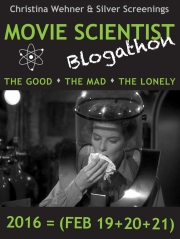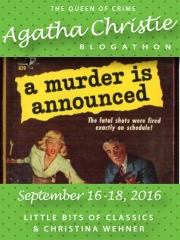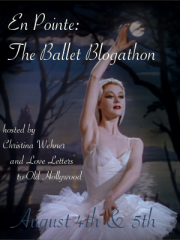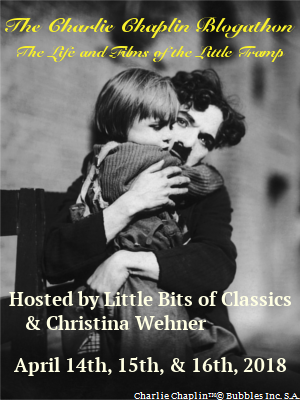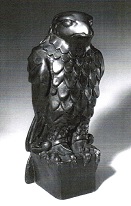 This book was made to be a movie. It’s so close it’s like watching the movie in slow motion in my head. There are occasional flashes of something new, a new scene, a new twist or interpretation, but for the most part it reads like a screenplay. Sam Spade does this, he says that, his eyes burn yellow (they do that a lot), he grinds his teeth, some description about a room, what Brigid O’Shaughnessy is wearing, how Joel Cairo walks, the tone of Gutman’s voice – stage direction.
This book was made to be a movie. It’s so close it’s like watching the movie in slow motion in my head. There are occasional flashes of something new, a new scene, a new twist or interpretation, but for the most part it reads like a screenplay. Sam Spade does this, he says that, his eyes burn yellow (they do that a lot), he grinds his teeth, some description about a room, what Brigid O’Shaughnessy is wearing, how Joel Cairo walks, the tone of Gutman’s voice – stage direction.
The book opens with Miss Wonderly (really Brigid O’Shaughnessy) coming into the office of Spade and Archer, two detectives in business together. She spins them a story about needing to find her sister and hires them to tail a man named Floyd Thursby. Miles Archer tails him, is murdered, and the story is off. Like the movie, it begins right off the bat with no other preamble other than a paragraph describing what Spade looks like. He sets out to uncover what is going on and meets the memorable Joel Cairo, Caspar Gutman and Gutman’s gunman, young Wilmer.
The book is noted for its colorful cast of characters even more than its story, and deservedly so. It’s the same with the movie. And they did such a fantastic job casting – or else I’ve seen the movie way too many times – that when I read I literally hear Humphrey Bogart’s voice saying the lines that I’m reading. I can see Mary Astor move her hands as described, or pause exactly where the pause is written in the book, I can hear Sydney Greenstreet laugh, see Peter Lorre walk and hold his hat with both hands, in front of his stomach. It’s very distracting, at times.
The opening description of Sam Spade, I absolutely could not see. He is described as looking “rather pleasantly like a blonde Satan,” but all I could see was Humphrey Bogart. It wasn’t until the second half of the book began to have more scenes and dialogue that I didn’t recognize that my imagination was able to kick in and Hammett’s description of Spade began to compete with the insistent image of Bogart.
Sam Spade in the book is actually a bit different from Spade in the movie. He is far less appealing than Bogart makes him. In the movie, Bogart is the moral center, which is not to be confused with being a moral person, but he does have a certain code he lives by, unlike any of the other people in the story. In the book, his moral code is far murkier.

Dashiell Hammett
And he’s a bit like a spoiled child – always “beefing” about the police’s treatment of him, grinding his teeth when frustrated, needling Wilmer, treating his secretary like a bit of a plaything, is ridiculously arrogant and self-assured and, amazingly enough, he gets away with it. Bogart presents a slightly more mature Spade. He keeps his cool better, has no tantrums and doesn’t seem quite so childishly pleased with himself.
If it comes to that, Mary Astor is also a more mature Brigid O’Shaughnessy. In the book, she is quite young – early twenties – and comes off even more helplessly than in the movie, even though she is anything but helpless. There’s lots of hand wringing and buckets of tears and large, frightened eyes. I would argue, however, that Astor’s Brigid is a slightly more complicated Brigid. She shifts character more than Brigid in the book and comes off as more intelligent. Brigid in the book is a liar, but Brigid in the movie is a mega-liar.
It’s not a particularly subtle book. People just come out and say stuff: “he’s queer” (about Joel Cairo) or “can I buy you with my body?” (Brigid O’Shaughnessy to Sam Spade). It’s stuff the movie had to skirt around to pass censorship. It makes the movie far more coy, though still explicit, about what is going on.
Like Raymond Chandler, Dashiell Hammett seems to be very interested in the process of detection. Details, even if they are not important, are described. For example, Spade is sent off on a red-herring. The house he is sent to is not important, merely being a place chosen at random, but we still get a description of his interview with the owner and of his search of the place. The important details are contained within other, non-important details. But there are no descriptions of people’s thoughts, their emotions; it’s the ultimate example of show, don’t tell. Spade speaks, his jaw clenches and we are left to infer what he is feeling.
Reading The Maltese Falcon reminded me of when I tried to read a book by Rex Stout called Over My Dead Body, about the detective Nero Wolfe and his assistant, Archie Goodwin. The book was so exactly like the TV series episode, with Maury Chaykin and Timothy Hutton, that there was literally nothing new to glean from reading the book. It’s an odd occurrence, because most movies don’t even begin to do justice to the books they are based on. The Maltese Falcon isn’t quite that bad, there really are some new things to learn and it is definitely worth a read – it’s just not as many new aspects as I thought.
Dashiell Hammett also wrote The Thin Man, which was turned into the 1934 movie with William Powell and Myrna Loy. However, unlike The Maltese Falcon, the book is quite different and I couldn’t even begin to see William Powell or Myrna Loy as I was reading. It is rare for me to ever see the actors from a movie while I am reading the book, no matter how good the movie.. Even movies that I adore, that I consider to be fairly faithful to the book they are based on (1995 Pride and Prejudice, with Colin Firth and Jennifer Ehle) cannot begin to capture the essence of the book I see in my mind. I still don’t see Colin Firth when I read about Mr. Darcy or hear Jennifer Ehle speak the lines…even though many are quite similar. The book is simply to much for a movie. Not so with The Maltese Falcon. It’s hard to imagine a movie doing it better. If it was any better, then the book would be obsolete…which is not something I would ever wish for a book.
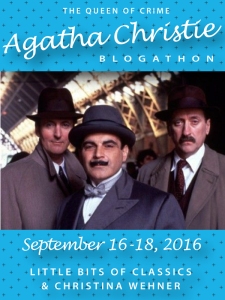 Just a reminder that next week the Agatha Christie Blogathon begins: Friday the 16th through Sunday the 18th! Domi from Little Bits of Classics and I are really looking forward to reading everyone’s entries.
Just a reminder that next week the Agatha Christie Blogathon begins: Friday the 16th through Sunday the 18th! Domi from Little Bits of Classics and I are really looking forward to reading everyone’s entries.

![220px-Bigsleep2[1]](https://christinawehner.wordpress.com/wp-content/uploads/2014/05/220px-bigsleep21.jpg?w=645)
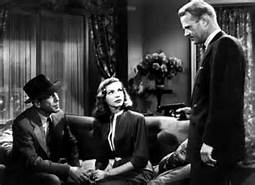
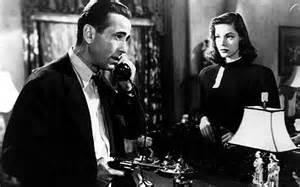
![img14[1]](https://christinawehner.wordpress.com/wp-content/uploads/2014/05/img141.jpg?w=300&h=168)
